Sephora App: Deep Analysis And Key Take Away To Build an eCommerce app

Sephora has established itself as a leading beauty retailer with a significant digital footprint, and the Sephora app is a prime example of a successful omnichannel strategy. The brand recognized early on the increasing role of smartphones in the shopping journey, even within physical stores, and proactively developed an application to cater to these evolving consumer behaviors. This foresight allowed Sephora to position itself as a dominant player in the smartphone retail arena, seamlessly integrating its online and offline marketing efforts to provide a comprehensive customer experience.
The company’s continued dedication to enhancing the features and functionality of the Sephora mobile app demonstrates an understanding of the dynamic nature of the digital landscape. This commitment is reflected in the substantial portion of their sales originating from e-commerce channels, with figures indicating that 58% of Sephora’s 2022 holiday sales were generated online, a notable increase from 43% in 2019. This trend underscores the vital importance of a robust online presence, including a sophisticated mobile application, for retailers aiming to capture a significant share of the market.
This analysis cover the Sephora app’s frontend, backend, features, and user reviews, drawing from various perspectives to give you a well-rounded picture. Therefore, it will help you imagine how your app could look and function while aligning with your eCommerce website.
Sephora app download: Sephora: Buy Makeup & Skincare For Android | Sephora US: Makeup & Skincare For iOS

>> You may also like:
- Sephora Marketing Strategy: Best Case Study for Shopify brand
- Sephora Net Worth, Revenue 2024 & Growth Strategy
- Top 7 eCommerce Apps for Your Inspiration in 2025
I. Sephora mobile app key features breakdown
1. Product Discovery and Browsing Capabilities
The Sephora mobile app makes exploring beauty products simple and enjoyable. Its user-friendly layout organizes items into clear categories like makeup, skincare, fragrance, and haircare—just like walking through a well-arranged store. This smart structure helps users quickly find what they’re looking for without feeling overwhelmed.
For those who know exactly what they need (or want to get specific), the app’s powerful search and filter tools are a game changer. You can narrow down products by brand, price, ingredients, and more—perfect for anyone with particular preferences or skin concerns.
Each product page is packed with helpful information, including high-quality images, ingredient lists, and how-to-use tips. You’re not just seeing a product—you’re getting the full picture to help you make confident choices.
What really stands out is the customer reviews. Real user feedback, ratings, and experiences are front and center, giving shoppers that extra dose of trust and guidance. Sephora clearly understands the power of peer recommendations, making the Sephora app not just a shopping tool, but a community-driven beauty hub.
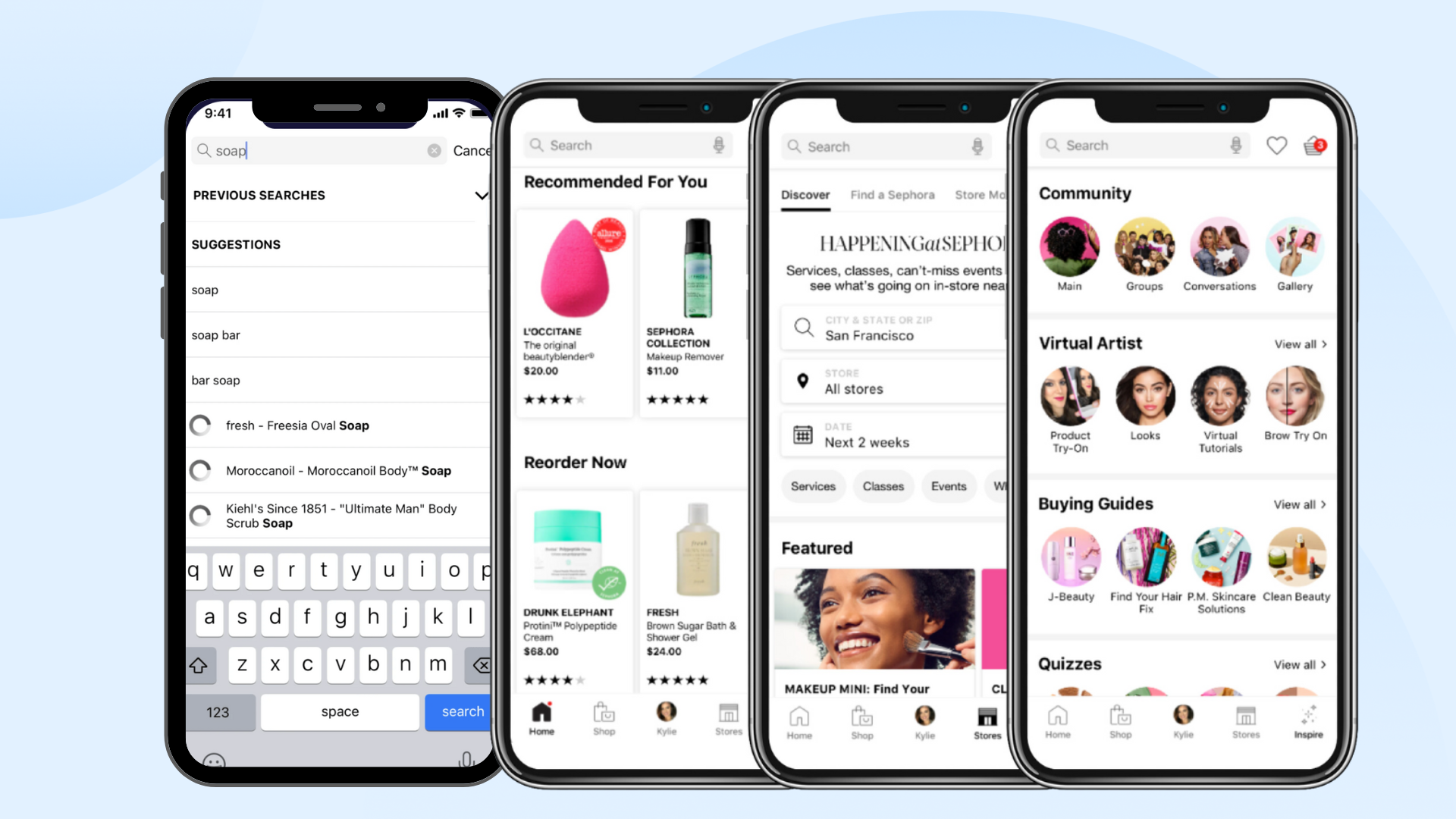
2. Personalized Recommendations and AI-Driven Features
A cornerstone of the Sephora mobile app is its sophisticated system for personalized product recommendations, heavily leveraging artificial intelligence (AI). The app analyzes a wealth of user data, including past purchases, browsing history, and stated preferences, to suggest products that are most likely to be relevant and appealing to each individual. This dedication to providing a tailored shopping experience recognizes that generic recommendations often fall short in the nuanced world of beauty products.
As part of this personalization strategy, the app features a “New For You” carousel, which showcases personalized promotions and greetings, further enhancing the feeling of a tailored experience. This section serves as a dynamic hub for users to discover new offers and products specifically curated for them.
To further refine its understanding of user needs and preferences, Sephora incorporates AI-powered quizzes within the app. These interactive quizzes ask users about their beauty routines, skin type, and specific concerns, enabling the app to generate even more precise and personalized product recommendations. This interactive approach not only aids in providing relevant suggestions but also actively engages users, gathering valuable data that continuously improves the accuracy of future recommendations.

>> Recommended reading:
3. Augmented Reality and Virtual Try-On Functionality
One of the standout features of the Sephora app is the Virtual Artist—a high-tech, highly praised tool that lets you try on makeup virtually using augmented reality (AR). With just your phone’s camera, you can see how different lipsticks, eyeshadows, foundations, and even false lashes look on you, in real time. The AI-driven tech accurately maps your facial features, giving a surprisingly realistic preview of each product before you buy.
Adding to that personalized experience are tools like Color IQ and Skin IQ, Sephora’s color-matching technologies. These features help you find the right foundation or complexion product by analyzing your skin tone. Whether you’re uploading a photo at home or getting scanned in-store with a handheld device, the data syncs directly to your app profile—making it easy to shop for the perfect shade anytime.
Together, these tools tackle one of the biggest hurdles in buying makeup online: choosing the right color. And by combining smart technology with convenience, Sephora makes the process feel effortless—and a little bit fun too.

>> Explore: AR in eCommerce: Use cases and best examples 2025
4. Loyalty Program (Beauty Insider) Integration
The Sephora app does a great job of bringing the Beauty Insider rewards program front and center. Users can effortlessly track their points, redeem perks, and access exclusive rewards—all from within the app. This seamless integration makes it easy to stay engaged with the program and feel truly rewarded for every purchase.
What makes it even better? Sephora regularly rolls out app-only promotions and bonus point events, giving loyal customers extra reasons to shop through the app. It’s not just about discounts—it’s about feeling like a VIP. This smart loyalty system helps deepen the connection between Sephora and its community, turning everyday shoppers into long-term fans.
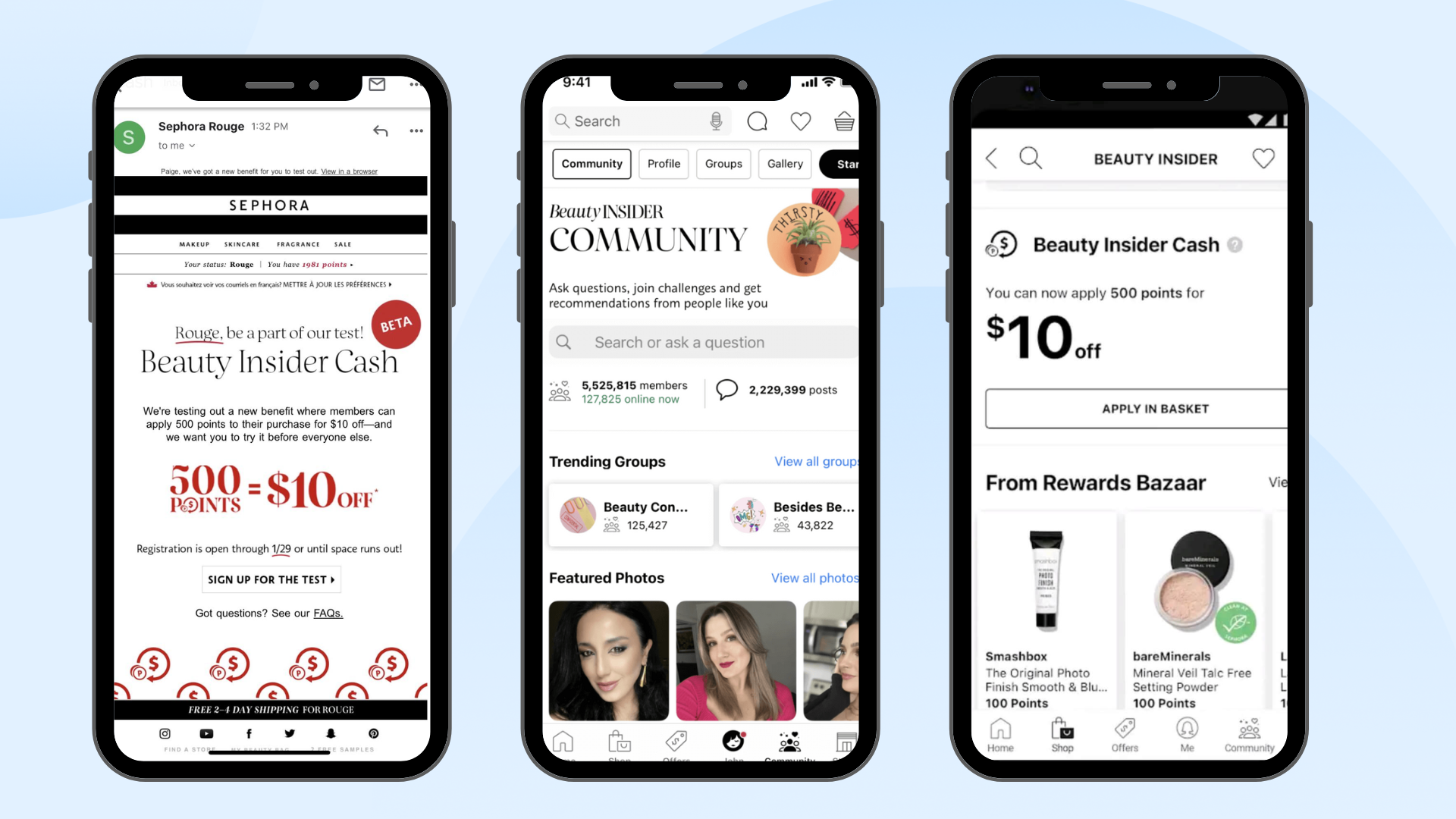
>> Explore: 7 Best Loyalty Program Apps To Boost Customer Retention
5. Shopping Cart and Seamless Checkout Process
The Sephora app is designed to make shopping as effortless as possible. From start to finish, the checkout process is smooth and intuitive. Users can securely save their payment methods and shipping details, making repeat purchases a breeze. A bold, easy-to-spot “Add to Cart” button keeps the buying journey on track, while in-app order tracking lets you monitor your delivery every step of the way.
To suit different shopping preferences, Sephora also offers Buy Online, Pick Up In Store (BOPIS). Whether you prefer the speed of home delivery or the instant gratification of in-store pickup, the app gives you the flexibility to choose what works best. This option doesn’t just offer convenience—it’s also a clever way to bridge the online and in-store experience, often leading to extra discoveries (and maybe a few impulse buys) during pickup.
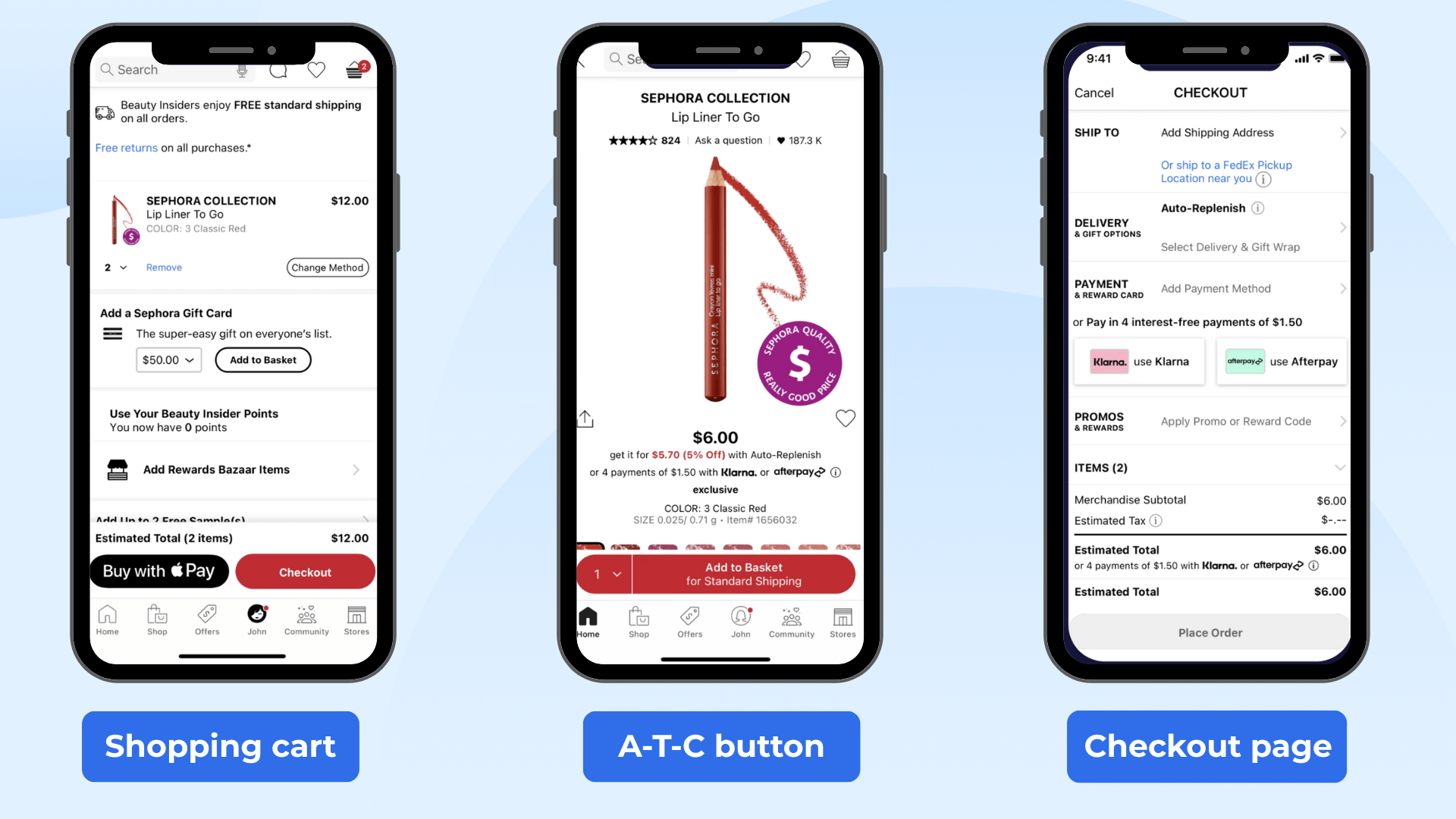
6. In-Store Experience Integration
Sephora has effectively integrated its mobile app with the in-store shopping experience through several key features. One notable functionality is barcode scanning, which allows users to instantly access product information, including ratings and reviews, simply by scanning the barcode of a product they are considering purchasing in a physical store.
The Sephora app also leverages location-based data to provide customers with store-specific information, such as in-store discounts exclusive to that particular location, and even offers a map of the store layout to help them find products more easily. Furthermore, users can check the availability of specific products at nearby physical stores directly through the app.
To facilitate store visits, the Sephora mobile app includes a store locator feature that utilizes GPS technology to help users find the nearest Sephora store. These integrated features demonstrate Sephora’s commitment to creating a seamless omnichannel experience, where the digital and physical aspects of shopping are interconnected and mutually reinforcing.
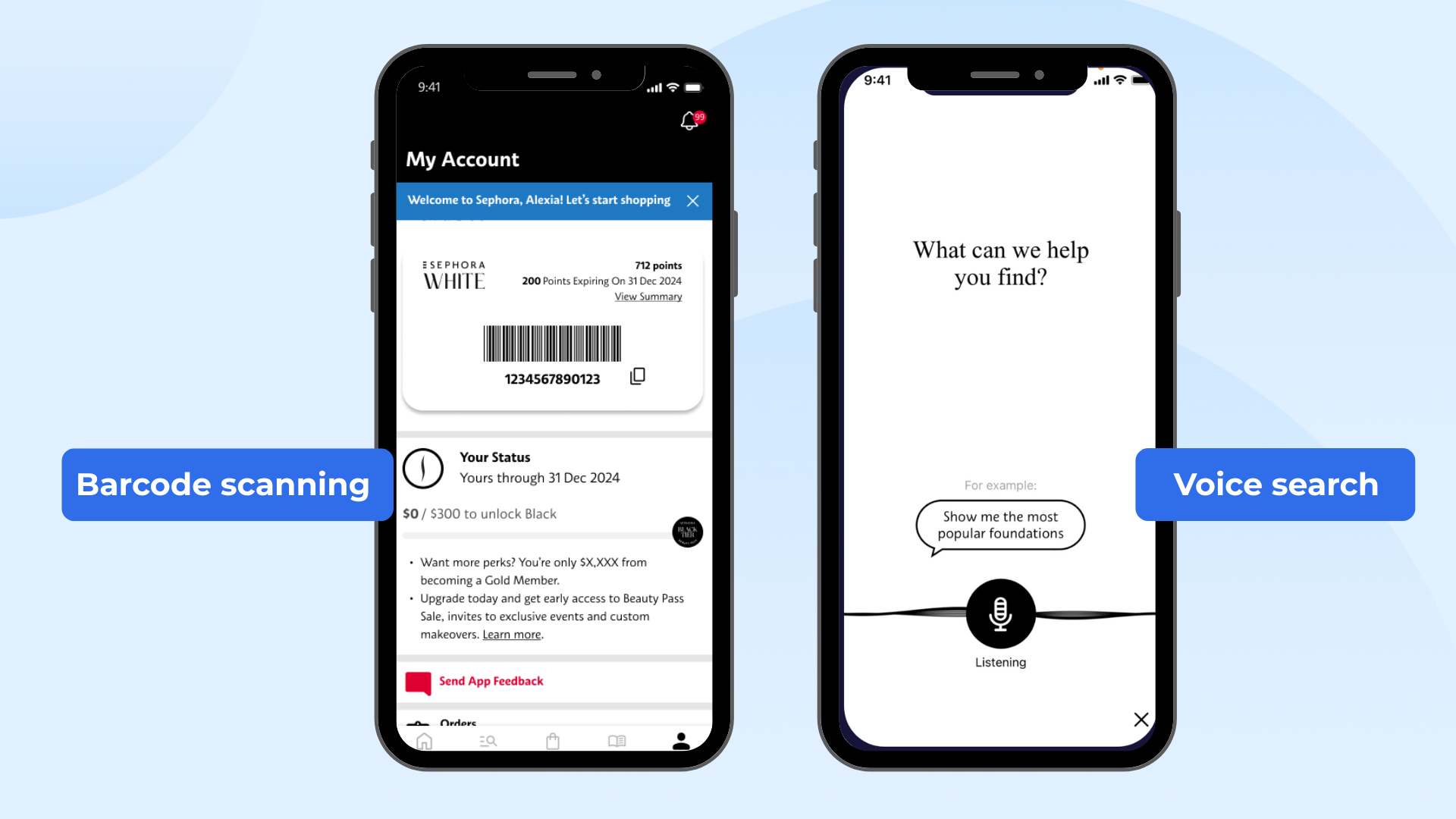
7. User Accounts and Order Management
The Sephora app streamlines user account management with easy sign-in options, including the convenience of Face ID for quicker access. Once logged in, users can readily access their order history and past purchases, making it simple to reorder their favorite items. The app also allows for the management of user profiles, where customers can save their basic information and beauty preferences, contributing to a more personalized shopping experience.
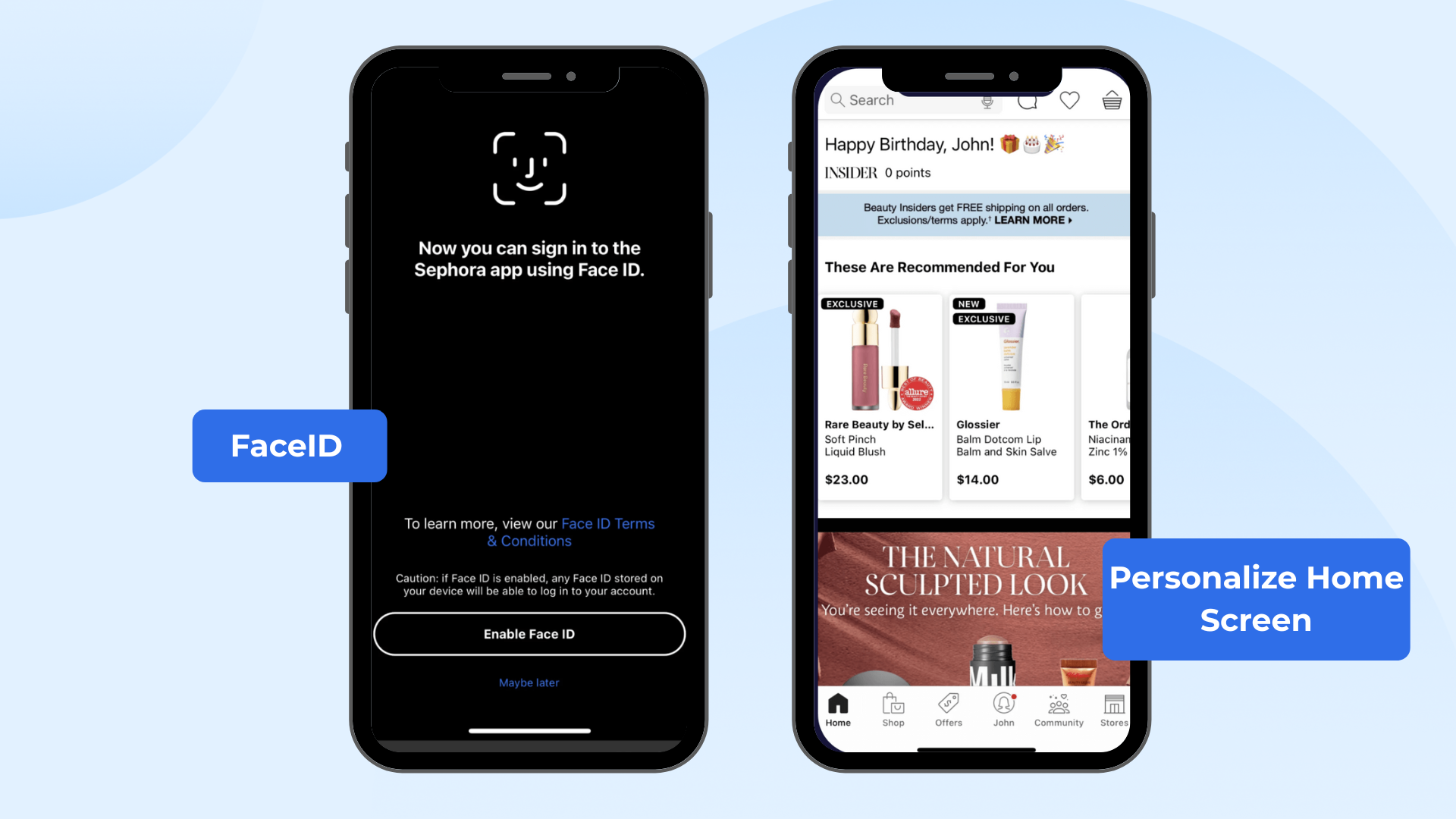
8. Community Features and User-Generated Content
Beyond transactional capabilities, the Sephora app fosters a sense of community among beauty enthusiasts. It integrates with the Beauty Insider Community, providing a platform for users to participate in discussions, share product reviews, and exchange beauty tips. The app also features a dedicated “Looks” section where users can share their own beauty looks and find inspiration from others within the community.
As previously mentioned, product reviews and ratings submitted by other users are prominently displayed, further encouraging interaction and providing valuable insights for potential buyers. The app also facilitates sharing on social media platforms like WhatsApp, Facebook, and X, allowing users to easily share their favorite makeup and skincare products with friends.
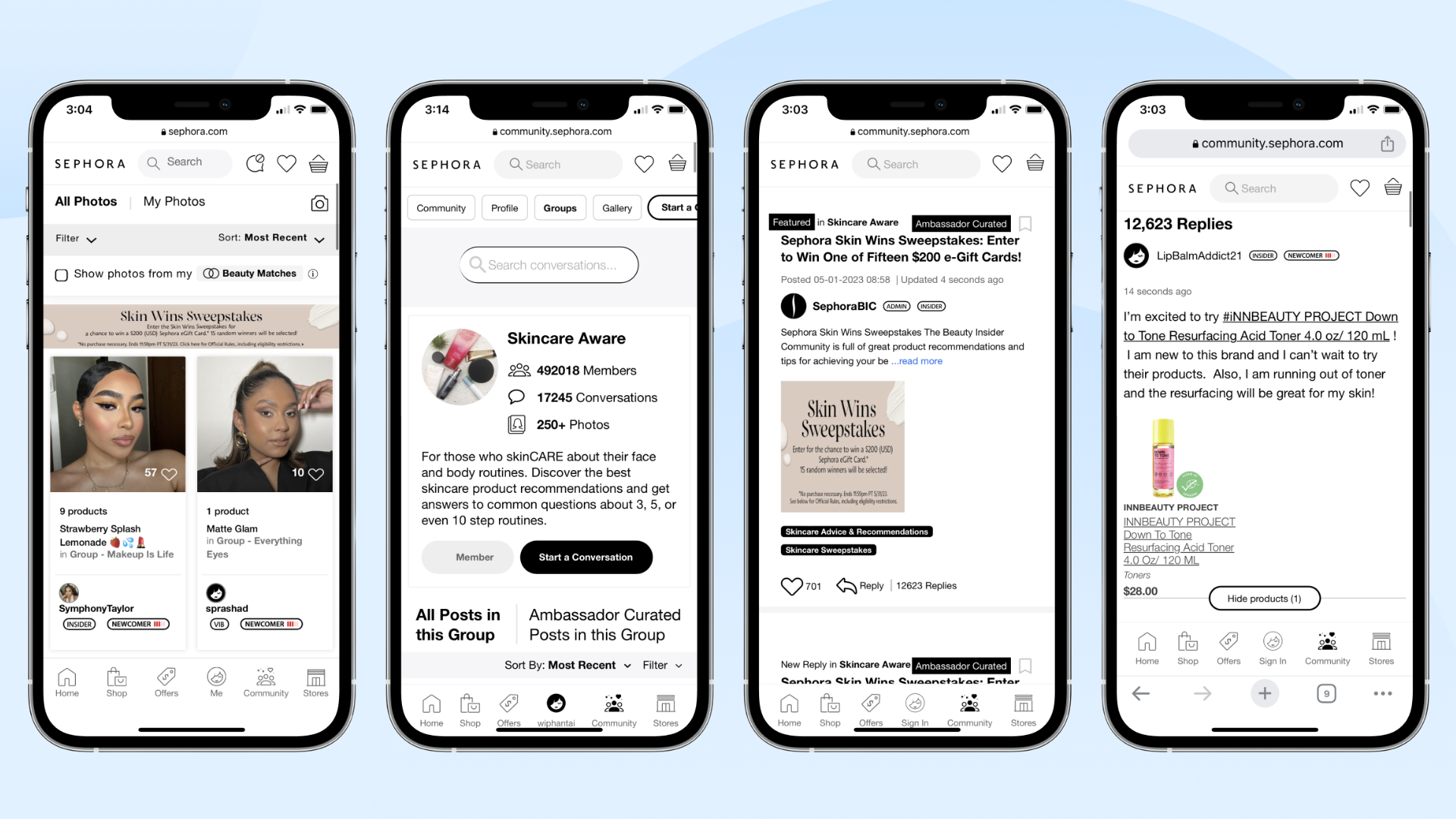
>> See more: 10 Best Shopify Review Apps With Pictures in 2025
9. Push Notifications and Personalized Alerts
Sephora utilizes push notifications and personalized alerts to enhance user engagement and provide timely information. Users receive alerts about new product launches, upcoming promotions, and in-store events, ensuring they stay informed about the latest offerings. Beauty Insider members also receive reminders about their rewards, including notifications to pick up complimentary birthday gifts. Furthermore, the app leverages location-based messaging to send users exclusive in-store deals and product recommendations when they are near a physical Sephora store.
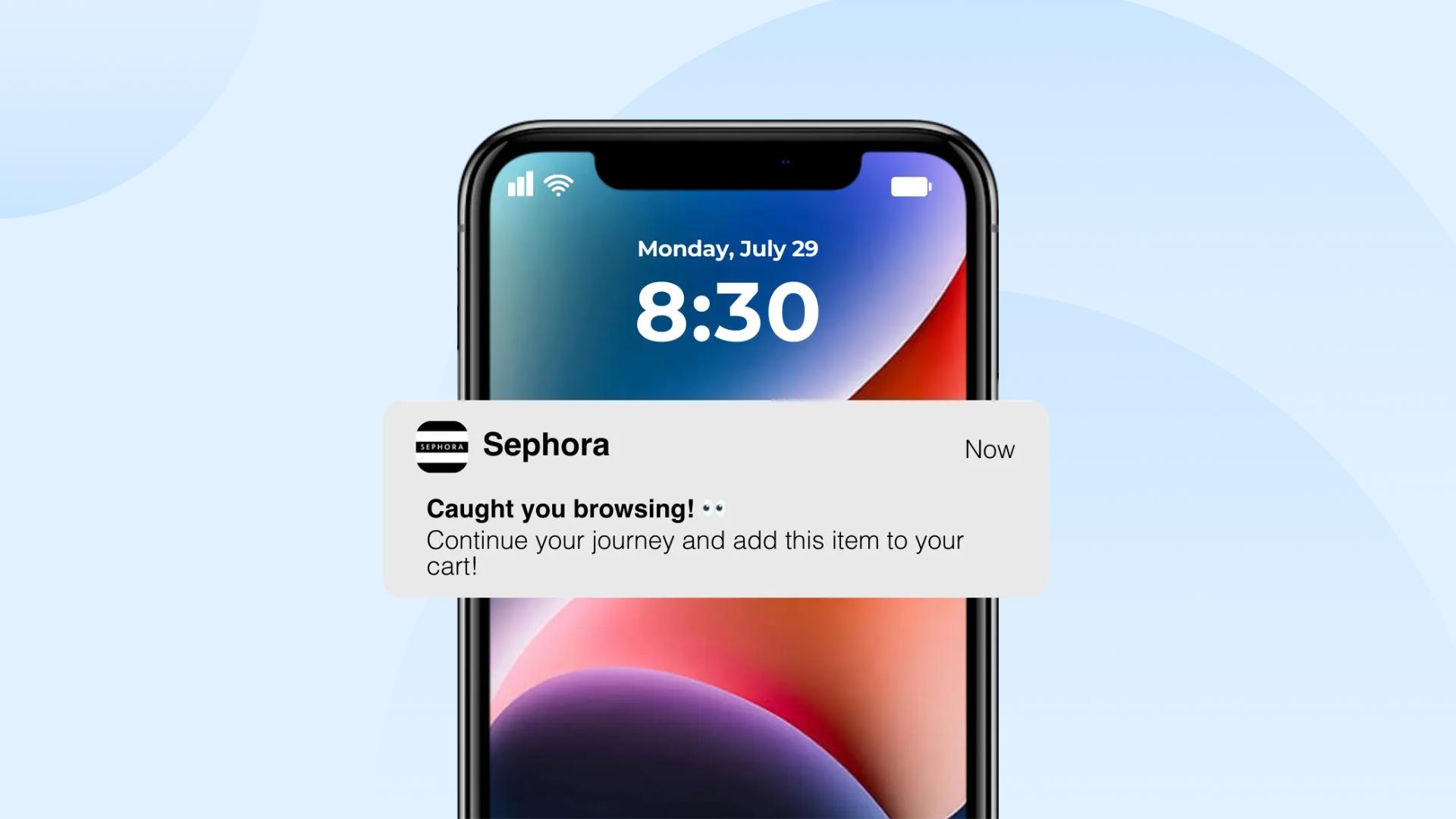
>> Read more: 7 Best Shopify Push Notification Apps For iOS and Android
II. Sephora app: technical deep dive
1. Frontend
The Sephora app is developed natively for both iOS and Android, ensuring optimal performance and a tailored user experience for each platform. This approach is evident from the development details for the Russian market, where Live Typing created both iOS and Android apps from scratch, adhering to Material Design for Android and using native development approaches (Live Typing Portfolio).
2. Backend Technology Stack
The backend of the Sephora app is designed to handle large-scale e-commerce operations, including product management, user profiles, transactions, and omnichannel integration. The evidence leans toward a combination of established e-commerce platforms and cloud-native solutions:
E-commerce Platforms
- Salesforce Commerce Cloud: Used globally for managing e-commerce operations, including product catalogs, shopping carts, and order management. Sephora has been leveraging this platform since at least 2018, with deployments in multiple countries, as noted in their partnership announcements (Sephora deploys Salesforce Commerce Cloud and Service Cloud – InfotechLead).
- commercetools: Adopted as the next-generation commerce solution starting in 2022. This headless commerce platform provides a MACH (Microservices-based, API-first, Cloud-native, Headless) architecture, enabling greater flexibility and scalability for Sephora’s digital transformation. This shift was announced in a press release, highlighting its role in unifying in-store and online experiences (Sephora Elevates The Future Of Commerce, Partners With commercetools As Next-Generation Commerce Solution – Sephora Newsroom).
Database and Storage
Custom APIs and databases are used to manage product data, user profiles, and transaction records. While specific details are not publicly available, large-scale e-commerce platforms like Sephora typically rely on robust cloud-based databases, possibly integrated with Salesforce or commercetools’ infrastructure.
Analytics and Tracking
- Firebase: Used for analytics, tracking user behavior, and managing app performance. This is confirmed for the Russian version, where Firebase supports deep linking, push notifications, and crash reporting (Live Typing Portfolio).
- AppsFlyer and AppMetrica: Additional analytics tools for monitoring app usage and marketing effectiveness, particularly noted in the Russian version.
Additional Technologies
- AI and Personalization: Sephora uses AI for features like personalized product recommendations, virtual try-ons (e.g., Virtual Artist), and tailored notifications. This is supported by integrations with tools like Firebase for data analytics and possibly other proprietary AI solutions, as mentioned in industry analyses.
- Omnichannel Integration: The backend supports seamless integration between online and in-store experiences, including features like in-store pickup, barcode scanning for product information, and unified loyalty programs (e.g., Beauty Insider). This is facilitated by the MACH architecture of commercetools, enhancing flexibility.
Sephora App Technology Stack (Inferred)
| Category | Technology/Framework |
| Frontend (Mobile) | Native iOS (Objective-C/Swift), Native Android (Java/Kotlin), Potential: React Native, Flutter |
| Frontend (Web – Integration) | React.js, Angular (Potential) |
| Backend/E-commerce Platform | commercetools (Next-Gen), Oracle ATG Web Commerce (Historically), Shopify (unofficial confirmation) |
| Cloud Services | Google Cloud AI, Microsoft Azure |
| CRM & Marketing Automation | Salesforce Marketing Cloud |
| Databases (Likely) | MySQL, PostgreSQL, MongoDB |
| AR/VR Libraries | ModiFace (for Virtual Artist) |
| Mapping Services | Google Maps API |
| Payment Gateways | Credit/debit cards (Visa, Mastercard, Discover, American Express), gift cards, eGift cards, and Paypal, Klarna or Afterpay for “shop now, pay later” options |
| Analytics & Tracking | Google Analytics, Firebase, Adobe Marketing Cloud, Akamai mPulse |
III. Sephora app review and sentiment analysis
User feedback provides valuable insights into the app’s performance and areas for improvement. From the App Store and expert reviews, as well as a recent Reddit discussion, here’s a detailed analysis:
1. Positive Feedback
- Ease of Use: Content loads quickly, and the shopping experience is smooth, similar to the website, with regular updates for deals. Rated 4.9 out of 5 with 423.7K ratings on the App Store.
- Convenience: Users love the ability to shop from home, scan products in-store, read reviews, and reorder past purchases, with features like My Loves List enhancing usability.
- Exclusive Deals: Access to Insider-only offers and promotions is a significant draw, especially for Beauty Insider members.
2. Areas for Improvement
- Usability Issues: Recent complaints include the app being “unusable,” with loading problems, cycling to the homepage, and difficulty scrolling, particularly noted in a Reddit thread with 424 votes.
- Search Functionality: Users report irrelevant search results and misspelled suggested queries, impacting the shopping experience.
- Sold-Out Products: Persistent display of sold-out items, with no option to filter for in-stock only, frustrating users, especially for items like UD palettes and Sephora Favorites sets over a year old.
- Login and Checkout Problems: Frequent login prompts despite being logged in, errors signing in, and checkout issues, including credit card and PayPal problems, with some orders canceled multiple times.
- Rewards and Sale Pages: Beauty Challenges not working, no points earned, and sale pages not loading properly, with prices not reflecting sales, adding to user frustration.
- Design and Features: Lack of dark mode, difficult zooming on product images, and inability to use Apple Pay on the app, noted as missing features.
IV. Key Considerations for Developing an eCommerce app like Sephora
As an eCommerce store owner, especially when operating your store via the Shopify platform, you can draw several lessons from the Sephora app to envision your mobile solution:
- User Interface and Experience: Prioritize a clean, intuitive interface with fast loading times, addressing usability issues like those reported by Sephora users. Ensure content loads quickly and the shopping experience is smooth, as noted in positive reviews.
- Search and Navigation: Implement accurate search algorithms and easy navigation to avoid the irrelevant results and misspelled queries seen in Sephora’s app, enhancing user satisfaction.
- Product Management: Ensure real-time inventory updates to prevent displaying sold-out items prominently, a significant pain point for Sephora users, and include filters for in-stock items.
- Personalization and Engagement: Incorporate features like virtual try-ons, beauty quizzes, and personalized recommendations to enhance engagement, mirroring Sephora’s successful personalization strategies.
- Loyalty and Rewards: Integrate a loyalty program similar to Beauty Insider, allowing users to earn points, access exclusive deals, and redeem rewards, which is a key driver of customer retention.
- Seamless Integration: Ensure the app integrates well with your Shopify backend for inventory, orders, and customer data, facilitating features like in-store pickup and barcode scanning for a unified experience.
Given the scale and complexity, consider using Shopify mobile app builders or integrating with existing solutions that support Shopify’s API for initial development, but for a highly customized experience like Sephora app’s, native development or frameworks like React Native might be necessary.
>> Recommended reading:
For Shopify store owners who want to reach more customers on mobile without the hassle of coding or expensive development, Simicart is the easiest no-code mobile app builder that allows you to quickly create and launch your own iOS and Android apps. Unlike complex or costly solutions, Simicart offers a simple drag-and-drop interface and a free plan to effortlessly tap into the power of mobile commerce.

